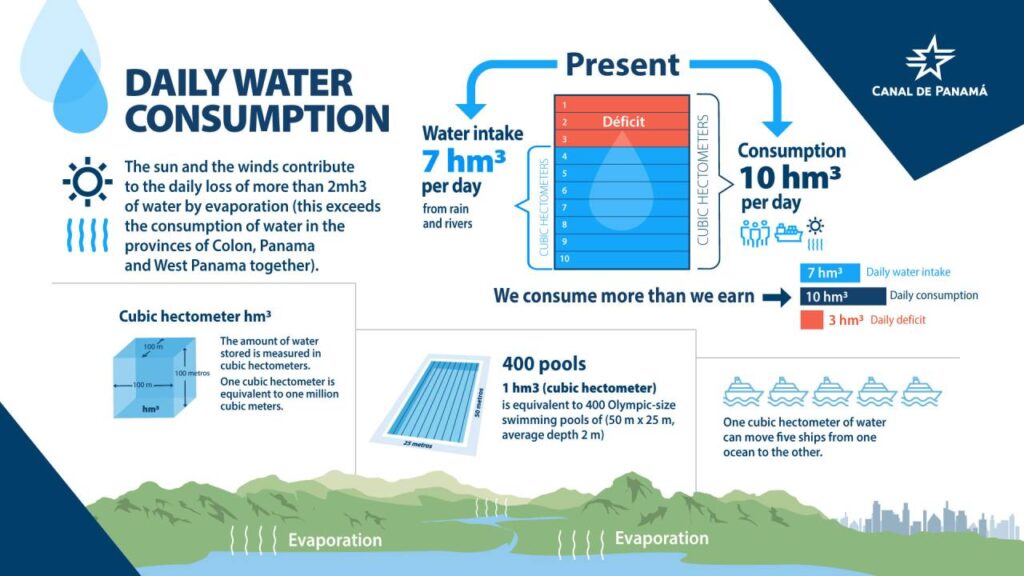
A Pancanal news source speaks about how the Canal Manages the Fresh Water Challenge.
Panama Canal statistics
The year 2023 has been particularly dry, according to Panama Canal statistics, primarily due to the effects of the El Niño phenomenon.
The rainy season in Panama typically begins in May and ends in November. However, during years when the El Niño phenomenon is active, such as this one, the onset of rains can be delayed, resulting in a prolonged dry season.
The El Niño phenomenon also negatively impacts evaporation in water bodies, significantly affecting critical sites like the Gatun and Alhajuela lakes, which rely on rainfall and river inflows.
Water Intakes and Consumption
Currently, the Gatun reservoir receives a daily inflow from rainfall and river flow amounting to seven hm³. However, the combined outflows from Canal operations, evaporation, human consumption, and industry amount to ten hm³. This results in a daily deficit of three hm³. In a year with typical rainfall, the water inflow would average 15 hm³ per day.
This means that for the year 2023, water consumption has surpassed Gatun lake intakes from rainfall and rivers, hence the Canal has had to maintain acceptable levels for operations through water accumulated during last year’s rainy season and transfers from the Alhajuela lake.
To offer some perspective: three cubic hectometers is equal to the water volume in 1,200 Olympic-sized swimming pools. This daily shortfall has caused the Gatun reservoir’s level to drop seven feet below its anticipated level for this time of year, marking the lowest level ever recorded during a rainy season in the reservoir’s history.
Because of the El Niño phenomenon, the average accumulated rainfall in the watershed for 2023 is 25.6% less than the average over the past 73 years.
To alleviate this fresh water scarcity, it would require an extreme storm, such as La Purisima in 2010, or a hurricane similar to Otto in 2016. However, such events are unpredictable and undesirable from other standpoints.
The next 80 days are pivotal for increasing storage in the Gatun and Alhajuela reservoirs, ensuring water regulation capacity is available for the upcoming dry season in 2024.
It is worth mentioning that the measures and operational adjustments made by the Panama Canal facilitate daily water savings of 1.2 million cubic meters. This amount is equivalent to 80% of the daily consumption in the provinces of Colon, Panama, and West Panama.
In response to the rising water demand and fluctuating rainfall patterns, the Canal has implemented operational and commercial adjustments to guarantee a fresh water supply for both human consumption and for transits during the next dry season, which runs from December 2023 to April 2024.
Thus, the Panama Canal upholds its commitment to the nation, aligned with one of its core strategic objectives: to ensure the availability and quality of fresh water for both, Canal operations and public consumption.
About the Panama Canal Authority (ACP)
The Panama Canal Authority (ACP) is an autonomous legal entity of the Republic of Panama in charge of the operation, administration, management, preservation, maintenance, and modernization of the Panama Canal, as well as its activities and related services, so that the Canal may operate in a safe, continuous, efficient manner. For more information, please refer to the ACP’s website: https://www.pancanal.com or follow us on Twitter @thepanamacanal.
Did you subscribe to our daily newsletter?
It’s Free! Click here to Subscribe!
Source: Pancanal

















